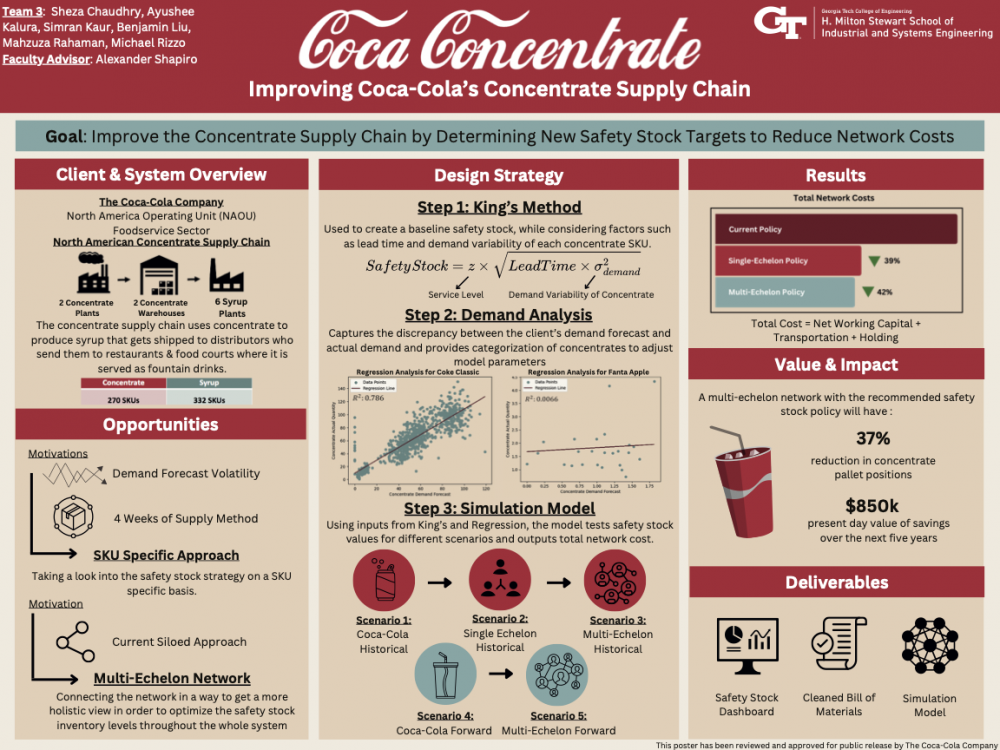Client Context
The Coca-Cola Company is a multinational corporation founded in 1892 that produces a variety of soft drinks, alcoholic and non-alcoholic beverages. Headquartered in Atlanta, Georgia, Coca-Cola employs ~700,000 employees and reported a net revenue of $45.8B in 2023.
This project mainly engages with the Supply Chain Optimization and Infrastructure Planning (SCIO) team, which operates within Coca-Cola's North America Operating Unit (NAOU). SCIO works with several teams including supply planning, demand planning, manufacturing operations, procurement, and finance. They are responsible for developing and evaluating optimization model outputs to service cross-functional partners with data to improve precision and accuracy across the supply chain. The project also includes stakeholders from the foodservice sector, which comprises partnerships and distribution networks within restaurants, dining halls, and other hospitality establishments.
The system of interest is the concentrate supply chain, which consists of 2 concentrate plants, 2 concentrate warehouses, and 6 syrup plants. When planning concentrate safety stock, the team has historically used a 3-4 weeks worth of demand at each node of the network.
Project Objective
The project’s objective was to provide Coca-Cola with new safety stock targets for their concentrate SKUs that was backed up with an empirical approach. The first opportunity to achieve this objective was using a SKU-specific approach for calculating safety stock. Different concentrates have different demand variabilities and therefore have different amounts of risk associated with meeting service levels requiring different safety stock targets. Thus, the team decided to take a SKU-specific approach for calculating safety stock. The second opportunity was to treat the supply chain as an interconnected, multi-echelon network. To do this, the team’s design strategy considers the different nodes within the network that store safety stock and their interactions for optimal inventory storage to reduce overall network costs while maintaining customer service level.
Design Strategy
The team worked through various approaches during this semester. Using King’s Method, initial safety stock numbers for each SKU were created based on demand variability, lead time, and service level. Through demand analysis, the team further looked at demand variability between each SKU to categorize the SKUs into predictable vs unpredictable and stable vs unstable SKUs. This helped to cater the safety stock targets to individual SKUs and their characteristics. Then, the team built a simulation model using a python script that mimics the real-world Coca-Cola's concentrate network with transportation flows and inventory storage at nodes. The team iteratively modified the safety stocks at each node to come up with the least cost scenario while maintaining service level.
To validate each regression formula used, two metrics were evaluated: the adjusted R-squared values and the p-values of model parameters. Although these were the metrics used to determine predictability of individual SKUS, they were also used to evaluate the effectiveness of model developed to generate pseudo-future demand. By looking at these metrics, the team was able to verify model correlation and statistical significance before using generated values in the model.
Validation of the simulation model was significantly less straightforward. Firstly, unit tests were executed to verify the correctness of the computational logic. The unit tests included testing a concentrate warehouse to a single syrup plant, a warehouse to multiple plants, two parallel networks on each coast, and then the entire network as a connected supply chain. Unit tests were also conducted to ensure the model worked for individual SKUs before expanding to simulate all of them. Past that, results were also discussed with the client to confirm feasibility of outputs.
Deliverables
The main project deliverable is a safety stock dashboard with new concentrate safety stock targets that consider each concentrate's unique characteristics. The simulation model is provided as a decision support tool to the client to be able to make data driven decisions in for the concentrate business and gain insight into the supply chain. Next, a clean Bill of Materials will provide the client with visibility into the conversions between concentrate and syrup that were not available in a centralized way before. Finally, the regression analysis provides concentrate segmentations to aid in concentrate planning in the future by grouping like concentrates together based on their stabilities and predictabilities. All these deliverables will help the client make unified decisions across the network alleviating the current siloed decision making.
Value and Impact
Through modification and overall reduction of safety stock, the client will be able to immediately save $600,000 across the network, and over the next five years bring in an additional $200,000 in present value through changes in cash flows. The concentrate safety stock inventory is reduced by 23% and the pallet spaces required is reduced by 37%.
The main value of this project is that it is a pilot for other parts of the business that use concentrate. While this project focused on the food service sector which only makes up about 23% of the entire NAOU volume, the recommendations and methodologies can be applied to the rest of NAOU.


